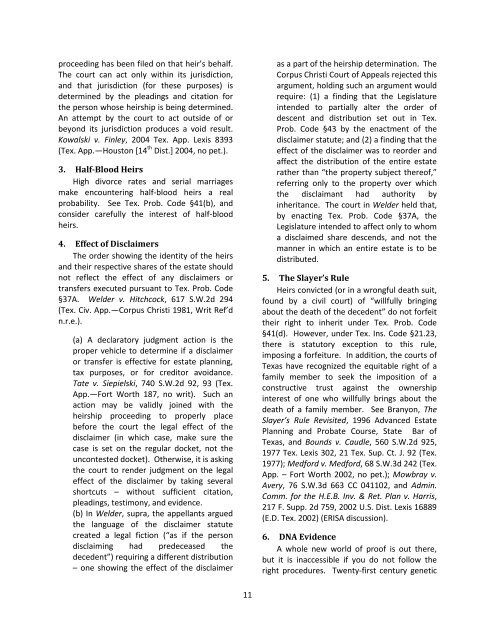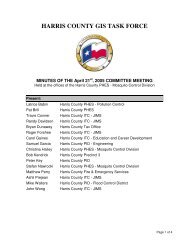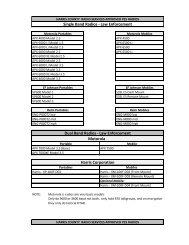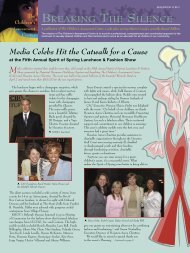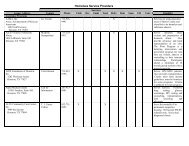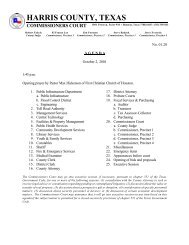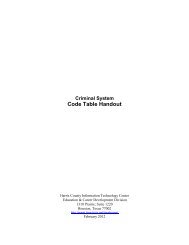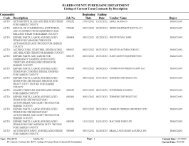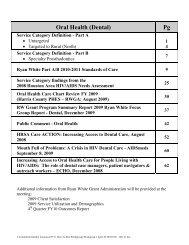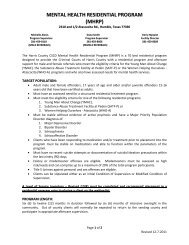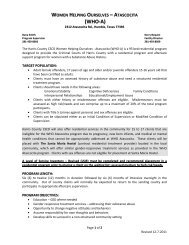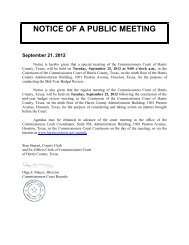Harris County Probate Courts The Ad Litem Manual for Heirship ...
Harris County Probate Courts The Ad Litem Manual for Heirship ...
Harris County Probate Courts The Ad Litem Manual for Heirship ...
You also want an ePaper? Increase the reach of your titles
YUMPU automatically turns print PDFs into web optimized ePapers that Google loves.
proceeding has been filed on that heir’s behalf.<br />
<strong>The</strong> court can act only within its jurisdiction,<br />
and that jurisdiction (<strong>for</strong> these purposes) is<br />
determined by the pleadings and citation <strong>for</strong><br />
the person whose heirship is being determined.<br />
An attempt by the court to act outside of or<br />
beyond its jurisdiction produces a void result.<br />
Kowalski v. Finley, 2004 Tex. App. Lexis 8393<br />
(Tex. App.—Houston [14 th Dist.] 2004, no pet.).<br />
3. Half-Blood Heirs<br />
High divorce rates and serial marriages<br />
make encountering half-blood heirs a real<br />
probability. See Tex. Prob. Code §41(b), and<br />
consider carefully the interest of half-blood<br />
heirs.<br />
4. Effect of Disclaimers<br />
<strong>The</strong> order showing the identity of the heirs<br />
and their respective shares of the estate should<br />
not reflect the effect of any disclaimers or<br />
transfers executed pursuant to Tex. Prob. Code<br />
§37A. Welder v. Hitchcock, 617 S.W.2d 294<br />
(Tex. Civ. App.—Corpus Christi 1981, Writ Ref’d<br />
n.r.e.).<br />
(a) A declaratory judgment action is the<br />
proper vehicle to determine if a disclaimer<br />
or transfer is effective <strong>for</strong> estate planning,<br />
tax purposes, or <strong>for</strong> creditor avoidance.<br />
Tate v. Siepielski, 740 S.W.2d 92, 93 (Tex.<br />
App.—Fort Worth 187, no writ). Such an<br />
action may be validly joined with the<br />
heirship proceeding to properly place<br />
be<strong>for</strong>e the court the legal effect of the<br />
disclaimer (in which case, make sure the<br />
case is set on the regular docket, not the<br />
uncontested docket). Otherwise, it is asking<br />
the court to render judgment on the legal<br />
effect of the disclaimer by taking several<br />
shortcuts – without sufficient citation,<br />
pleadings, testimony, and evidence.<br />
(b) In Welder, supra, the appellants argued<br />
the language of the disclaimer statute<br />
created a legal fiction (“as if the person<br />
disclaiming had predeceased the<br />
decedent”) requiring a different distribution<br />
– one showing the effect of the disclaimer<br />
11<br />
as a part of the heirship determination. <strong>The</strong><br />
Corpus Christi Court of Appeals rejected this<br />
argument, holding such an argument would<br />
require: (1) a finding that the Legislature<br />
intended to partially alter the order of<br />
descent and distribution set out in Tex.<br />
Prob. Code §43 by the enactment of the<br />
disclaimer statute; and (2) a finding that the<br />
effect of the disclaimer was to reorder and<br />
affect the distribution of the entire estate<br />
rather than “the property subject thereof,”<br />
referring only to the property over which<br />
the disclaimant had authority by<br />
inheritance. <strong>The</strong> court in Welder held that,<br />
by enacting Tex. Prob. Code §37A, the<br />
Legislature intended to affect only to whom<br />
a disclaimed share descends, and not the<br />
manner in which an entire estate is to be<br />
distributed.<br />
5. <strong>The</strong> Slayer’s Rule<br />
Heirs convicted (or in a wrongful death suit,<br />
found by a civil court) of “willfully bringing<br />
about the death of the decedent” do not <strong>for</strong>feit<br />
their right to inherit under Tex. Prob. Code<br />
§41(d). However, under Tex. Ins. Code §21.23,<br />
there is statutory exception to this rule,<br />
imposing a <strong>for</strong>feiture. In addition, the courts of<br />
Texas have recognized the equitable right of a<br />
family member to seek the imposition of a<br />
constructive trust against the ownership<br />
interest of one who willfully brings about the<br />
death of a family member. See Branyon, <strong>The</strong><br />
Slayer’s Rule Revisited, 1996 <strong>Ad</strong>vanced Estate<br />
Planning and <strong>Probate</strong> Course, State Bar of<br />
Texas, and Bounds v. Caudle, 560 S.W.2d 925,<br />
1977 Tex. Lexis 302, 21 Tex. Sup. Ct. J. 92 (Tex.<br />
1977); Med<strong>for</strong>d v. Med<strong>for</strong>d, 68 S.W.3d 242 (Tex.<br />
App. – Fort Worth 2002, no pet.); Mowbray v.<br />
Avery, 76 S.W.3d 663 CC 041102, and <strong>Ad</strong>min.<br />
Comm. <strong>for</strong> the H.E.B. Inv. & Ret. Plan v. <strong>Harris</strong>,<br />
217 F. Supp. 2d 759, 2002 U.S. Dist. Lexis 16889<br />
(E.D. Tex. 2002) (ERISA discussion).<br />
6. DNA Evidence<br />
A whole new world of proof is out there,<br />
but it is inaccessible if you do not follow the<br />
right procedures. Twenty-first century genetic


